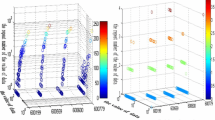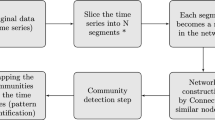Abstract
In order to extract the time pattern of traffic flow fluctuation in terminal area and realize the macroscopic description of traffic flow in terminal area. A time pattern recognition method of traffic flow in terminal area is proposed. Firstly, the traffic flow in the terminal area is counted, the time scale is determined according to the characteristics of data distribution, and the flow time series is established. Secondly, time series are mapped into complex networks by using visibility graph. Finally, time series segmentation and time pattern recognition are realized by community division of complex networks. Based on the experimental data of 4998 arrival flights within a week in a terminal area, the time series is established and the experiment is carried out. Experimental results show that with transformation of time series into complex networks, the dynamic segmentation of time series can be realized by community division, and the accurate identification of different fluctuation modes of time series can be realized while maintaining the dynamic segmentation of time series.












Similar content being viewed by others
Data Availability
Raw data were generated at the Automatic Dependent Surveillance-Broadcast equipment. Derived data supporting the findings of this study are available from the corresponding author upon request.
References
Taehyung K, Hyoungsoo K, Cheol O, Bongsoo S Traffic flow forecasting based on pattern recognition to overcome memoryless property. 2007 International Conference on Multimedia and Ubiquitous Engineering. pp. 1175–80
Hu H, Gao Z, Sheng Y, Zhang C, Zheng R (2019) Traffic Density Recognition Based on Image Global Texture Feature. Int J Intell Transp Syst Res 17(3):171–180. https://doi.org/10.1007/s13177-019-00187-0
Fan S, Liu D, Duan L (2022) Codimension-2 Bifurcation Analysis of Macroscopic Traffic Flow Model. Lixue Xuebao/Chinese J Theor Appl Mech 54(2):482–494. https://doi.org/10.6052/0459-1879-21-509
Woodruff GM, Kositpaiboon R (1990) Multimedia Traffic Management Principles for Guaranteed ATM Network Performance. IEEE J Sel Areas Commun 8(3):437–446. https://doi.org/10.1109/49.53019
Liu X-G, Wang H-N, Hong J-W, Hao L (2021) Speed control strategy and optimization of signalized intersection in network environment. Jiaotong Yunshu Xitong Gongcheng Yu Xinxi/J Transp Syst Eng Inf Technol 21(2):82–90. https://doi.org/10.16097/j.cnki.1009-6744.2021.02.012
Bakker B, Whiteson S, Kester L, Groen FCA (2010) Traffic light control by multiagent reinforcement learning systems. In: Babuška R, Groen FCA (eds) Interactive Collaborative Information Systems. Berlin, Heidelberg: Springer Berlin Heidelberg, pp 475–510
Dong C, Shao C, Zhou X, Meng M, Zhuge C (2014) Kalman filter algorithm for short-term jam traffic prediction based on traffic parameter correlation. J Southeast Univ (Nat Sci Ed) 44(2):413–419. https://doi.org/10.3969/j.issn.1001-0505.2014.02.033
Yue Y, Yeh AGO, Zhuang Y Prediction time horizon and effectiveness of real-time data on short-term traffic predictability. IEEE Conference on Intelligent Transportation Systems, Proceedings, ITSC. pp. 962–967
Krause B, von Altrock C, Pozybill M Intelligent highway by fuzzy logic: congestion detection and traffic control on multi-lane roads with variable road signs. Proceedings of the Fifth IEEE International Conference on Fuzzy Systems. FUZZ-IEEE '96 (Cat. No.96CH35998). pp. 1832–7
Zhang L-L, Jia Y-H, Niu Z-H, Liao C (2014) Traffic State Classification Based on Parameter Weighting and Clustering Method. Jiaotong Yunshu Xitong Gongcheng Yu Xinxi/J Transp Syst Eng Inf Technol (6):147–151. https://doi.org/10.3969/j.issn.1009-6744.2014.06.023
Xiangjie K, Xu Z, Shen G, Wang J, Yang Q, Zhang B (2016) Urban Traffic Congestion Estimation and Prediction Based on Floating Car Trajectory Data. Future Generation Computer Systems 61:97–107. https://doi.org/10.1016/j.future.2015.11.013
Weibin Z, Yinghao Yu, Yong Qi, Feng S, Yinhai W (2019) Short-term traffic flow prediction based on spatio-temporal analysis and CNN deep learning. Transportmetrica A: Transp Sci 15(2):1688–1711. https://doi.org/10.1080/23249935.2019.1637966
Wang C, Zheng X, Wang L (2017) Research on nonlinear characteristics of air traffic flows on converging air routes. Xinan Jiaotong Daxue Xuebao/J Southwest Jiaotong Univ 1:171–178. https://doi.org/10.3969/j.issn.0258-2724.2017.01.024
Yuanyuan Z, Yang S, Cai Q, Sun P Traffic Flow forecasting based on chaos neural network. Paper presented at the 2010 International Conference on Information Technology for Manufacturing Systems, ITMS 2010, January 30, 2010 - January 31, 2010, Macao, China, pp. 1236–1240
Wang F (2019) Nonlinear fractal characteristics of air traffic flow. Xinan Jiaotong Daxue Xuebao/J Southwest Jiaotong Univ 54(6):1147–1154. https://doi.org/10.3969/j.issn.0258-2724.20180328
Haleem K, Alluri P, Gan A, Li H, Li T (2013) Synthesis of the advance in and application of fractal characteristics of traffic flow
Liu S-X, Chen W-S, Chi Q-Y, Yan H (2017) Day-to-day dynamical evolution of network traffic flow with elastic demand. Acta Phys Sin 66(6):060501(14pp.). https://doi.org/10.7498/aps.66.060501
Zhang Y, Xue Yu, Zhang P, Fan D, di He H (2019) Bifurcation analysis of traffic flow through an improved car-following model considering the time-delayed velocity difference. Physica A 514:133–140. https://doi.org/10.1016/j.physa.2018.09.012
Zhaoyue Z, Zhang A, Sun C, Xiang S, Li S (2020) Data-driven analysis of the chaotic characteristics of air traffic flow. J Adv Transp 8830731 (17 pp). https://doi.org/10.1155/2020/8830731
Xu J, Ronggai Xu (2013) Review of time-delayed car following models and bifurcation phenomena. Adv Mech 43(1):29–38. https://doi.org/10.6052/1000-0992-12-012
Zhang ZN, Lan-Tian LI (2019) Crowding degree assessment of air traffic network based on air traffic flow. Sci Technol Eng 19(1):268–272. https://doi.org/10.3969/j.issn.1671-1815.2019.01.041
Wang H, Ruiying W, Yifei Z (2015) Analysis of topological characteristics in air traffic situation networks. Proc Instit Mech Eng Part G (J Aerosp Eng) 229(13):2497–505. https://doi.org/10.1177/0954410015578482
Zheng XF, Wang C (2015) Arrival pattern recognition of terminal airspace traffic flow. Aeronaut Comput Tech (3):67–71. https://doi.org/10.3969/j.issn.1671-654X.2015.03.017
Blondel VD, Guillaume JL, Lambiotte R, Lefebvre E (2008) Fast unfolding of communities in large networks. J Stat Mech: Theory Exp 2008(10):P10008 (12 pp.). https://doi.org/10.1088/1742-5468/2008/10/P10008
Acknowledgements
This work was supported by the Fundamental Research Funds for the Central Universities and CAUC special fund under Grant 3122022105.
Author information
Authors and Affiliations
Corresponding author
Ethics declarations
Conflict of Interest
The authors declare that there is no conflict of interest.
Additional information
Publisher's Note
Springer Nature remains neutral with regard to jurisdictional claims in published maps and institutional affiliations.
Rights and permissions
Springer Nature or its licensor (e.g. a society or other partner) holds exclusive rights to this article under a publishing agreement with the author(s) or other rightsholder(s); author self-archiving of the accepted manuscript version of this article is solely governed by the terms of such publishing agreement and applicable law.
About this article
Cite this article
Zhang, Z., Yang, Y. Time Pattern Recognition of Traffic Flow in Terminal Area Based on Community Division. Mobile Netw Appl 27, 2543–2552 (2022). https://doi.org/10.1007/s11036-022-02079-2
Accepted:
Published:
Issue Date:
DOI: https://doi.org/10.1007/s11036-022-02079-2




